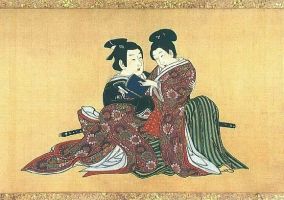Nenja: Difference between revisions
(Added a missing blank space to the first paragraph of the article) |
(Replaced an image, and modified the first paragraph of the article) |
||
| Line 1: | Line 1: | ||
[[File: | [[File:Miyagawa Isshô-Spring Pastimes-A.jpg|284px|right|<i>Nanshoku</i>-type tryst between a samurai and a boyfriend. Panel from <i>Spring Pastimes</i> (ca. 1750), a series of ten homoerotic scenes by Miyagawa Isshō. <i>Shunga</i>-style painted hand scroll (<i>kakemono-e</i>); <i>sumi</i>, color and <i>gofun</i> on silk. Private collection.]] | ||
'''Nenja''' (念者, "lover" or "admirer"), in premodern [[Japan]], was a term applied to the older and sexually active male partner involved in a [[Homoerotic (dictionary)|homoerotic]] relationship with a ''[[wakashū]]'' (若衆, "youth"), a sexually passive [[Adolescence|adolescent]] boy, in the context of the historical practice of ''[[shudō]]'' (衆道, "the way of youths"), also known as ''[[nanshoku]]'' (男色, "male love"), which was customary among members of the Buddhist clergy and of the [[samurai]] class. | |||
'''Nenja''' (念者, "lover" or "admirer"), in premodern [[Japan]], was a term applied to the older and sexually active male partner involved in a [[Homoerotic (dictionary)|homoerotic]] relationship with a ''[[wakashū]]'' (若衆, "youth"), a sexually passive [[Adolescence|adolescent]] boy, in the context of the historical practice of ''[[shudō]]'' (衆道, "the way of youths"), also known as ''[[nanshoku]]'' (男色, "male love"), which was customary among members of the Buddhist clergy and of the [[samurai]] nobility, and later adopted by some individuals of the rich merchant class. | |||
The sense of the word can be rendered as "a person who thinks of a particular youth", the character ''nen'' (念) being of difficult translation, as its meaning falls somewhere between rational "thinking" and emotive "feeling". Unlike the term ''wakashū'', its counterpart ''nenja'' had no age signifier, although it was expected in principle that the lover would be older than his beloved.<ref>Gregory M. Pflugfelder, ''Cartographies of Desire: Male-Male Sexuality in Japanese Discourse, 1600–1950'' (Berkeley: University of California Press, 1999), p. 36.</ref> | The sense of the word can be rendered as "a person who thinks of a particular youth", the character ''nen'' (念) being of difficult translation, as its meaning falls somewhere between rational "thinking" and emotive "feeling". Unlike the term ''wakashū'', its counterpart ''nenja'' had no age signifier, although it was expected in principle that the lover would be older than his beloved.<ref>Gregory M. Pflugfelder, ''Cartographies of Desire: Male-Male Sexuality in Japanese Discourse, 1600–1950'' (Berkeley: University of California Press, 1999), p. 36.</ref> | ||
Revision as of 22:25, 31 August 2021

Nenja (念者, "lover" or "admirer"), in premodern Japan, was a term applied to the older and sexually active male partner involved in a homoerotic relationship with a wakashū (若衆, "youth"), a sexually passive adolescent boy, in the context of the historical practice of shudō (衆道, "the way of youths"), also known as nanshoku (男色, "male love"), which was customary among members of the Buddhist clergy and of the samurai nobility, and later adopted by some individuals of the rich merchant class.
The sense of the word can be rendered as "a person who thinks of a particular youth", the character nen (念) being of difficult translation, as its meaning falls somewhere between rational "thinking" and emotive "feeling". Unlike the term wakashū, its counterpart nenja had no age signifier, although it was expected in principle that the lover would be older than his beloved.[1]
References
- ↑ Gregory M. Pflugfelder, Cartographies of Desire: Male-Male Sexuality in Japanese Discourse, 1600–1950 (Berkeley: University of California Press, 1999), p. 36.